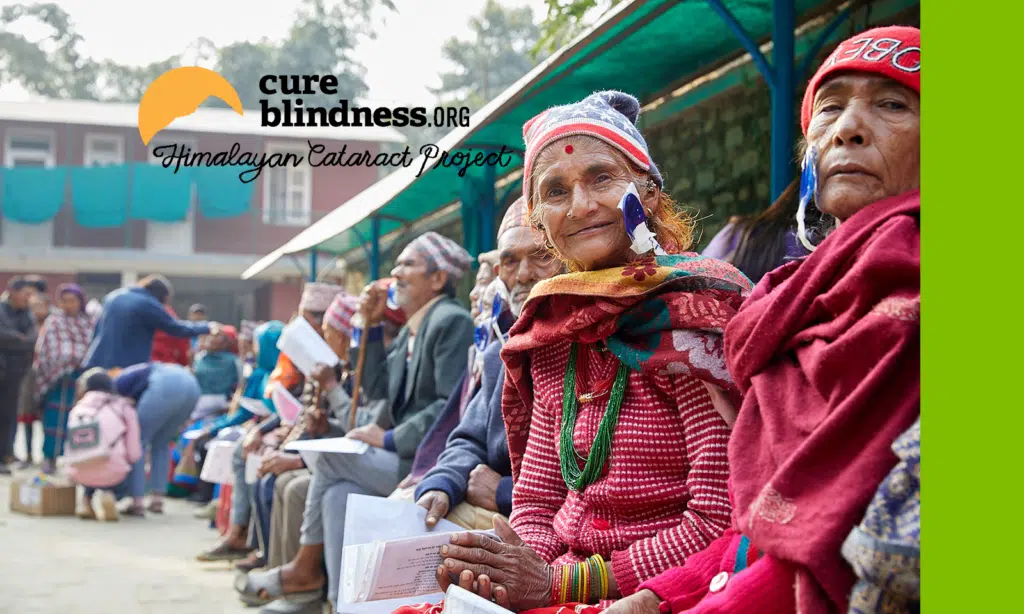The 2 million cataract surgeries that are performed in the U.S. each year make the procedure feel routine, when actually the results are quite extraordinary. Last year, I had an opportunity to personally see this in action.
In early 2020, right before the COVID-19 pandemic halted non-essential medical procedures, my dad underwent cataract surgery in both eyes. The surgery was a game-changer – it greatly improved his quality of life by restoring his ability to drive safely at night and read without glasses. Seeing these amazing results made me want to learn more about one of Global Impact’s partners, the Himalayan Cataract Project, and I was blown away by how they help restore not only eyesight, but also livelihoods in some of the lowest-income areas of the world.
For more than 25 years, the Himalayan Cataract Project has brought this miraculous modern medical procedure to the blind in Nepal. They partner with the world’s first low-cost interocular lens (the lenses used in cataract surgery to restore sight) factory, which produces lenses of exactly the same quality as those that are in my dad’s eyes. The cost is a mere $4 per lens – or 2% of the cost of those used in the U.S. The surgical techniques they developed ensure the highest quality eye surgery, reducing the $3,000 average cost of cataract surgery to just $25.
That’s right: For just over $20, someone’s vision could be restored to 20/20!
The value of eyesight
Take a moment and consider what you would do if you woke up one morning without your sight. What parts of your daily routine would you still be able to do with ease? What would be more difficult? Could you do your current job, or the hobbies you love?
In places like the U.S., it is easier to find the support those without their vision need, yet even so vision is still valuable. I myself cherish my ability to see because my eyes enable me to ride my horse, Dancer, which is both one of my favorite pastimes and a treasured opportunity to bond with her.
Sight would likely mean something different to me if I lived in a low-income country, and Dancer is a constant reminder of that fact. Due to complications from an autoimmune disease, both of her eyes had to be surgically removed. Every day, I am amazed by what my horse is able to do without her eyes. But, let’s face it: she is a horse and is fortunate to have her basic needs (food, safety, shelter) provided by me and her caretakers. I know that in contrast many of the millions of blind people around the world are not so lucky – that for them it could even be a matter of life or death.
Vision around the world
90% of the world’s visually impaired live in low-to-middle-income settings where taking care of basic needs is challenging already. According to the Himalayan Cataract Project website:
“The life expectancy of people once a person goes blind in a low-income country is reduced by one-third in comparison to that of healthy peers. For blind children the fate is much worse. And the devastation of blindness extends beyond the individual to the family and the community, because it takes an additional able-bodied person out of the workforce to care for the blind person, or a child out of school to lead their father around.”
Dr. Geoff Tabin, one of the founders of the Himalayan Cataract Project, climbs mountains for fun. He credits his years of climbing, training and pushing himself to the limit as the catalyst that taught him to take on impossible feats. In fact, his expedition to climb the east face of Mt. Everest in 1983, after completing medical school, allowed him to see firsthand the consequences of extreme poverty on health and be exposed to the hospitals that explorer and philanthropist Sir Edmund Hillary built in Nepal. This sparked Tabin’s desire to specialize in ophthalmology and return to Nepal to partner with Dr. Sanduk Ruit, the Himalayan Cataract Project’s other co-founder, to work to eliminate unnecessary blindness.
The results that the Himalayan Cataract Project achieves are astounding. By refining their techniques over the years, one of their ophthalmologists can complete more than 100 sight-restoring cataract surgeries in a day! About 80% of the patients can see well enough to pass a driving test just one day after surgery. Since the 1990s, in part due to their astounding achievements, the rate of blindness in Nepal alone has dropped from one blind person per 100 to less than 0.2%.
The Himalayan Cataract Project has been expanding its low-cost, high-impact cataract surgery model to other low-to-middle-income areas around the world. They now operate in 20 countries throughout the Asia and sub-Saharan Africa with an operating budget that has grown from $500,000 to more than $10 million.
Few other organizations can boast doing such life-changing work in mere minutes, using little more than $20 worth of materials.
The Himalayan Cataract Project is literally restoring sight to the blind, and it truly is amazing! I myself may never have the chance to be at a clinic in-person as the bandages are removed from a patient’s eyes, so they can see again for the first time in possibly years. But reading the heartwarming stories and seeing the photos of delight when patients can once again see the faces of their loves one on the Himalayan Cataract Project’s website is pretty transformative. Do yourself a favor, and see it for yourself.





